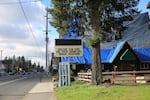For four months, Katie slept in a bunk bed in Portland’s largest shelter for homeless families.
She lay on the bottom half of the cot while one of her young sons slept above her. The family dog, a pug-lab-pit bull mix named Princess, spent her nights in a car in the shelter parking lot.
“I couldn’t imagine having to get rid of her. That would destroy my boys,” Katie said.
Related: Rodents, Pigeons And Gas Leaks: Issues Plague Portland Shelter For Homeless Kids
Katie grew up in Northeast Portland. Before her sons were born, she worked as a dog groomer. Katie has been a victim of domestic violence in the past and asked OPB use a pseudonym for her.
Life inside the shelter was difficult. Her family shared a room with 130 other people. Some of them struggled with drug and alcohol addiction. Often, the sound of arguments kept her from sleeping.
She made an effort to keep her sons, ages 11, 13 and 14, busy during the days with school, wrestling and friends so they only had to spend time in the shelter at night.
“They’ve been through a lot in their little lives,” she said.
Still, Katie was grateful for her bunk bed. While her family was homeless, there was a line they never had to cross: her family has never slept on the street.
Last year, when the house Katie was living in sold and rental debt made it hard for her to find a new place, she was able to immediately get into the emergency shelter run by the nonprofit Human Solutions.
A Promised Bed For Every Child
The shelter, funded by the city of Portland and Multnomah County through the Joint Office of Homeless Services, had a policy that was unique on the West Coast.
It promised to provide a bed for every child that needed one. It didn’t turn any family away and had no wait list.
The shelter didn’t screen out families for issues like drug addiction or criminal history, and it let families stay together: children, parents, grandparents — even dogs were welcome.
And on nights when all 130 beds were in use and the other roughly 50 beds dedicated to homeless families in Portland had people sleeping in them, the county paid for hotel rooms for the extra families.
This no-turn-away policy was a point of pride for Multnomah County, which was working to expand shelter access in response to Portland’s housing crisis.

The Human Solutions Family Center is the largest shelter for parents and children who are homeless in Multnomah county.
Amelia Templeton / OPB
When the number of homeless families sleeping on the street dropped in the county's count of homeless people in 2017, it credited the no-turn-away shelter with making the difference.
Just a handful of other cities — including New York and Washington, D.C. — have similar policies. Massachusetts is the only state that has recognized a right to shelter for families.
But while Multnomah County celebrated its no-turn-away policy, it wasn’t prepared to deal with the financial and practical challenges of managing it.
By late 2017, the no-turn-away policy had plunged Portland’s family shelter system into financial crisis because the number of families that needed a place to sleep kept rising.
In February 2016, when the shelter first opened, it served about 150 people a night using the shelter and overflow space in a church across the street.
That fall, the number of families at the shelter and the overflow space climbed to around 200 a night, and staff with the Joint Office of Homeless Services grew concerned that the shelter was dangerously overcrowded.
So, the office authorized the shelter to provide motel vouchers to homeless families when the shelter filled.
Last June, the number of families in the system began to rise again. Over the summer, it doubled.
By October 2017, the nightly census hit 468 people. The number of families staying in motels, paid for by the city and county, outnumbered the families at the shelter itself.
Katie’s family was among the last to benefit from the no-turn-away policy.
A few weeks after she arrived at the shelter in October, the Joint Office of Homeless Services capped the number of people in the system and started placing homeless families on a waitlist.
“We’ve had people showing up at the door and the staff has had to turn people away into the cold,” Katie said. “That’s heartbreaking.”
An Overwhelmed System
Earlier in this series, OPB reported that the building Human Solutions was housing these families in had serious problems, including rodents, pigeons and a problematic roof. The county evacuated the shelter in February after it became clear the roof was failing.
County staff said one reason they didn’t pay more attention to the building is that they were so overwhelmed by the rising number of homeless families.
“It frankly put our system into crisis. It became unsustainable for us,” said Mark Jolin, director of the Joint Office of Homeless Services, which coordinates shelter for Multnomah County and the city of Portland.
Records also show that Human Solutions cut its budget for maintenance, repairs, and staffing at the shelter to make more funding available to place families in motels.
Housing one family in a motel for a month costs the city and the county $3,318 on average. Housing a family at the Human Solutions shelter for a month costs $2,265.
By contrast, the average rent on a two-bedroom apartment in Portland is roughly $1,800.
Related: Warning About Portland Family Shelter's Roof Problems Missed Or Ignored
The expense of the ever-growing number of families in motels quickly depleted Human Solutions’ funding from the county.
The Joint Office of Homeless Services’ proposed budget for the family shelter system for the current fiscal year from July 1, 2017 to June 30, 2018 was $2 million. That was based on an estimate that 200 families would need shelter every night.
By Nov. 1, 2017, the Joint Office had spent or committed $3.5 million to the family shelter. The county was faced with the prospect of having to cut off funding to families staying in motels as winter hit.
In December, to contain the costs, the Joint Office moved many of the families out of motels and into a new emergency winter shelter it opened at Congregation Beth Israel. County leaders appealed to the Oregon Legislature for $2.4 million to keep the system afloat through the end of the year.
“Without additional funding, shelter system capacity will need to be reduced immediately by more than 250 people,” Gov. Kate Brown wrote in a letter urging state lawmakers to help.
The rising number of families in motels had other consequences. Critics say the motels, often on 82nd Avenue, isolated the families placed there.
Molly Frye is a social worker for the Reynolds School District, which serves many of the children staying at the family shelter.
Frye said the decision to place dozens of families in motels was poorly managed and created chaos for the school system.
“We only knew about it when our kids didn’t show up for school,” she said.
Frye struggled to get an accurate list from Human Solutions of which families had been placed in motels, and what their addresses were.
The motels on 82nd Avenue were far from the schools many of the children at the shelter had been attending – too far for the kids to safely walk.
So Frye sent her team to knock on motel doors and locate their missing students. Then, she rerouted a school bus for them.

When the Human Solutions Family Center reached capacity, the shelter provided families with vouchers to stay at motels. But the motels often isolated children from their schools and funds for the vouchers soon ran out.
Amelia Templeton / OPB
“We’ve set up a bus that goes along 82nd Avenue to the motels. If a student is further out, we usually need to send a cab to pick them up,” she said.
In 2017, the Joint Office spent record amounts on programs like rent assistance to prevent homelessness. The Portland City Council passed a policy requiring landlords to pay relocation costs for tenants displaced by rising rents or evicted without cause.
Jolin said he can’t pinpoint a single reason why, in spite of those efforts, the number of families in the shelter system rose so quickly.
“The only thing that I know for sure is that it tells us something about how many families in our community, in our region, are struggling because they can’t afford the rent anymore,” he said.
Frye said she’s worked with students in East Multnomah county for 15 years. Families in her district have been hit hard by rising rents and the housing crisis.
Related: More Than 8,000 Homeless Students Recorded In Portland Area
And the number of homeless students keeps rising.
“When I first began this job, the count that we sent in to the Oregon Department of Education, I believe in 2002, was that we had 15 homeless kids. And then last year, our count was 1,300,” she said.
The plight of homeless students could be one reason why the number of families in the shelter system started to surge last June.
Homeless families are far more likely to couch surf or live doubled up with friends and relatives than they are to stay in shelters or live on the street.
In 2017, the Oregon Department of Education reported a record number of homeless students in the state: 22,541 children from kindergarten to 12th grade, or 3.9 percent of the public school population.
Of those students, 17,210 were living in doubled-up situations.
Other cities, like New York, have noted surges in the number of families trying to get into a shelter when the school year ends.
"When the kids are back in the household during the day, those overcrowded situations are really untenable," said Jacquelyn Simone with the Coalition For the Homeless, a New York nonprofit.
“Sometimes, landlords are letting people stay through the school year,” she said. “And then things fall apart after that.”
'I Heard About The No-Turn-Away Shelter Here In Portland'
But evidence also suggests that the no-turn-away policy in Portland, and word that motels were available, contributed to the rise in families in the shelter system.
At the Human Solutions family shelter last fall, some homeless families spoke of their experiences being turned out of shelters in other cities.
Vanessa Orange and her young daughter were among those waiting for turkey and ham in the dinner line a few days before Thanksgiving.
Orange grew up in Warm Springs, Oregon, and said she and her children first became homeless in Yamhill County.
“I came here because time had expired in Yamhill County shelters, and then I couldn’t find any other place to go at the time,” she said. “Then I heard about the no-turn-away shelter here in Portland.”
Yamhill County’s shelter confirmed families can only stay there for up to six months.
Another resident described arriving in Portland with his wife and son on a Greyhound bus after being turned away by shelters that were full in Salem and Bingen, Washington.
“Families migrated to the shelter from all over the country,” said Frye.
She said the homeless families she works with at the Reynolds School District share a wide variety of reasons for coming to Portland.
“Some families said that in the area that they were at, they felt their homeless status was more criminalized than they felt would happen in Portland,” she said. “One family told us that they were afraid of gang violence on a daily basis, and felt that Portland would be safer.”
Human Solutions gathered zip code data from shelter residents by asking them, “What was your last permanent address?”
Adult Shelter Residents By ZIP Code
The Human Solutions Family Shelter, marked with a red dot, in East Portland. People there have come from many counties, often for a job or family connections. Some lacked shelter in their hometowns.
Source: OPB Reporting
More than 800 adults, representing about 500 families, answered the question. About 45 percent gave addresses in Portland or Multnomah County.
Significant numbers said their last addresses had been in other cities in the Portland metro area that do not fund the shelter, including Vancouver, Beaverton and Oregon City.
Smaller numbers said they’d come from communities across western Oregon, including Salem, Eugene, Medford and Seaside.
And about one-third of the shelter residents reported their last permanent address wasn’t in Oregon. They came from dozens of states, including Alaska, Nevada, Louisiana, Texas and Virginia.
Brown noted the comparatively high numbers of families from other Oregon counties in her letter urging state lawmakers to fund Multnomah County’s request for shelter funding.
“The County’s no-turn-away family shelter has noted a rise in clients coming from surrounding communities,” the governor wrote.
In emails to Joint Office staff, Human Solutions Executive Director Andy Miller has called the zip code data unreliable and pointed out that it doesn’t capture the reasons why families are traveling to Portland.
Jolin and others caution against reading too much into the fact that people at the shelter have come from other counties, and in some cases, other states.

A majority of Portland residents come from somewhere else. One homeless family mapped their journey with artist Rachel O'Rourke for the project Migration Patterns.
Amelia Templeton / OPB
Portland itself is a city of migrants. Fewer than half the people who live here are "homegrown" or from Oregon, according to Census data.
Human Solutions also surveyed 125 families coming into the shelter last fall. The nonprofit was trying to determine if the rising numbers were a result of word spreading that motel rooms were available in Portland.
Of those families, only six said they had come due to lack of shelter in their home communities, about 5 percent of the total.
“Most of the out-of-area folks came here because they had local ties (from here, friends here, employment here) and became homeless after they arrived,” Miller wrote in an email to Joint Office staff. “This is really a local issue as much as it is a subset of a statewide and national housing crisis.”
Miller shared a slightly different version of the Joint Office survey data with OPB. That version of the data shows that only about half the families in Human Solutions’ sample answered the question about why they’d traveled, meaning the complete percentage of families that lacked shelter in their home communities is unclear.

Families at Portland's largest shelter gave many reasons for traveling: to reunite with family, to escape domestic violence, for employment or because they lacked shelter in their hometowns.
Amelia Templeton / OPB
The city's family shelter system is no longer on the brink of crisis. State lawmakers stepped in this month and set aside an extra $5 million for shelter beds statewide, which included the funding the Joint Office requested.
Today, Portland and Multnomah County no longer claim they can provide a warm, safe bed for every family that needs a place to sleep.
Last week, more than 200 families in the city were on a waitlist for a shelter bed. Nearly 100 families said they were staying with family or friends in the meantime. Seventy-five reported sleeping in a vehicle.
And 45 families with children reported they would be sleeping on the streets.

